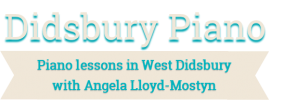
Here’s how I use a Pop-It fidget toy for a quickfire review of piano pentascales. If you’re not sure what a pentascale is, then read on for a quick explanation below the video. If you’re not sure what a Pop-it is then speak to an 8 year old!
When my pupils are learning how to construct pentascales, they then colour in dots to help them remember the pattern of white and black keys on the keyboard for each pentascale. Like this:

Source: Piano Safari Technique Book Level 2
We can have some fun popping the “black keys” by popping up the bubbles one of these pop-its:
I set them a challenge to beat me and do it in less than 10 seconds.: ( and I had to do it left handed AND hold a phone to video myself- in-built teacher handicap right there!)
Prior to doing this, my pupils constantly forgot the F# in B major! The pop-it solved it!
Making links with circle of 5ths- it’s never too early!
Teachers- I use the circle of 5ths as that’s the order I teach them, and they begin to learn them in pairs of same/similar start patterns. Then I put the letter tiles (just made from from circular 2x 2 Lego tiles) on the keyboard to show them how each new key is a 5th up.
Finally I have them play each pentascale- in a chain of 5ths up the keyboard.
What is a pentascale?
It’s simply the first 5 notes of a scale, which is a pattern of whole and half steps from a given start note. Major scales sound happy- think Do-Re-Mi-Fa-So-La-Ti-Do like in The Sound of Music!). Minor scales can sound sad. angry, impish, mysterious- think the first 7 notes of In the Hall of the Mountain King , or the song Charlie is My Darlin’
Why not just do the whole octave scale straight away?
I used to do this…and it’s an efficient way of ticking the scales box in exams. But here are 5 reasons I introduce pentascales first:
1) Since they only use 5 notes and we have 5 digits, no finger shifts are required. This means you can start learning the patterns at a very early stage.
2) Students can learn to play in any key, feeling confident in keys with many sharps or flats, because they understand the patterns. The Tonic WWHW (or TTST) pattern is short and easy to remember. Then it’s only really a case of adding 2 more whole steps to build a whole scale
3) It’s provides a great framework for lots of improvisation- using a pentascale means it will easily “work”. The confidence and boost that this “sounding good” gives students makes them feel happy to explore improvising!
4)They help us to easily identify triad chords- simply notes 1- 3 -5 of the pentascales.
5) Enables students to transpose pieces at an early stage, which is great for pattern recognition.
